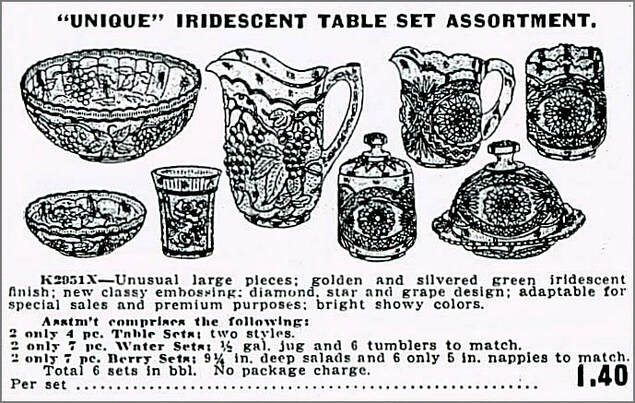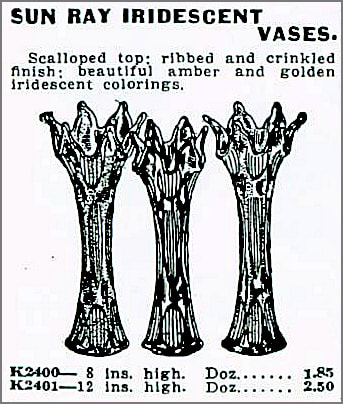G. Sommers & Co., 1926 Catalogue
We are extremely grateful to Stan Hoegerman for providing us with these catalogue extracts
and permission to show them on this page. The extracts are Stan's Copyright.
and permission to show them on this page. The extracts are Stan's Copyright.
In several articles elsewhere on this website, we look at how Mail Order (both wholesale and retail) played a vital role in the sale and distribution of Carnival Glass, enabling the makers to get their wares to the buying public. G. Sommers and Co. may not be as well-recognised as, say, Butler Brothers, Sears Roebuck, or Montgomery Ward, but it was significant nonetheless.
|
G. Sommers & Co. was a wholesale supplier based in Minneapolis / St. Paul. The company began in 1882 (as B. Sommers & Co.) growing into one of the largest businesses of its kind in the USA before closing in 1940. Low prices, good quality merchandise, strong mail-order advertising, and honest dealing were considered to be key to its operations. Its main area of distribution ranged westwards from the Great Lakes to the Pacific Ocean, and from the Canadian border to California. On the right is a Carnival Glass assortment made by Imperial. The patterns are Imperial Grape (bowl, berry and pitcher), Lustre Rose tumbler, and Imperial Hobstar table set (creamer, spooner, covered sugar and covered butter). It's interesting that the ad paired together an Imperial Grape pitcher and a Lustre Rose tumbler, although Imperial actually made an Imperial Grape tumbler. The description - "golden and silvered green iridescent finish" is undoubtedly Imperial's Helios green. The reference in the ad to "premium purposes" was directed at the retail market, where the use of "Premiums" - that is sales incentives - was a popular device used in retail catalogue sales. We have documented many examples of this around the World in our unique feature: Sell it to me! |
|
The Carnival Glass pieces offered in this 1926 catalogue were primarily from Imperial. In addition to the one shown above, there were four more Imperial Glass selections included in the catalogue. Three Imperial bowls: the top one is Open Rose; in the centre is Hattie; the bottom piece is Imperial Grape. Although the heading said "Colored Glass", the descriptions made it clear that they were all iridescent.
|
Four Imperial patterns are offered here in various shapes - all are in "Rubigold", Imperial's name for marigold Carnival. The patterns are Heavy Diamond (top row, the handled nappy on the left and the handled sugar / creamer in the centre, and the bowl on the bottom row, left);
Frosted Block (the two handled item on the top row, left, the bowl, middle row left, another two handled piece in the centre of the bottom row, and the bowl to its right); Star Medallion (the bowl in the middle row, on the right); and Optic and Buttons (bowl, top row second from the left, the low bowl and the two handled piece in the centre of the middle row). |
|
Above: this assortment featured Windmill (left and centre)
and Open Rose (on the right). The colours were marigold and Helios. The assortment on the right offered Heavy Grape (bowl, top left, and the 8" "Fancy Candy Plate" on the bottom row); Windmill (top row, centre, and the small sized [milk] pitcher and ruffled bowl on the bottom row, left and right respectively); Pansy (sugar and creamer, top row on the right, and the handled bonbon in the middle row); Imperial Grape (the comport on the bottom row). All of them were offered in four colours. |
Other makers included in this Sommers catalogue:
|
The only inclusion from Fenton was this ad for their Diamond and Rib vases. It is the same selection that was in the Sommers 1910 catalogue, but the price had risen from 90c to $1.85 - $2.50 per dozen.
|
|
We have other extracts from an earlier G. Sommers catalogue - from 1910 - which featured several assortments of Fenton's Carnival Glass. They are published with grateful thanks to, courtesy and Copyright of Joy Stallock Ostlund, here: G. Sommers & Co. Catalogue, 1910







